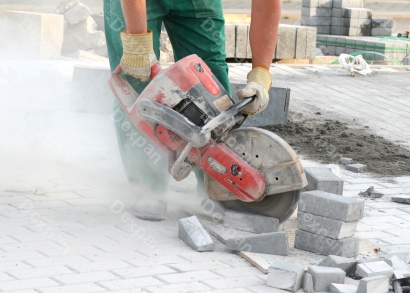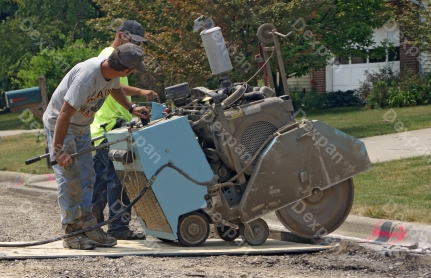|

What is a
Diamond
Blade?
Diamond
blade is a circular saw blade used for cutting,
sawing or
abrasive materials. Diamond blades are commonly used in the
construction for building, remodeling and repairs,
often used for cutting concrete, brick, block, stone
and other materials.
A diamond blade has a
steel core which is combined with diamond segments.
Diamond crystals and powder metal are heated and
pressed into a molding which form the diamond
segments, also known as the "cutting teeth" of the
blade. The diamond segments are then welded to the
steel core.

How the Diamond Blade
Works
Diamond blades do not
really cut, instead diamond blades grind material through an
action of friction with the synthetic
diamond-bonding matrix. The diamond crystals, often
visible at the leading edge and sides of the rim /
segment, remove material by scratching out particles
of hard, dense materials, or by knocking out larger
particles of loosely bonded abrasive material. This
process eventually cracks or fractures the diamond
particle, breaking it down into smaller pieces.
As a result of this
phenomenon, a diamond blade for cutting soft,
abrasive material must have a hard metal matrix
composition to resist this erosion long enough for
the exposed diamonds to be properly utilized.
Conversely, a blade for
cutting a hard, non-abrasive material must have a
soft bond to ensure that it will erode and expose
the diamonds embedded in the matrix. These simple
principles are the foundation of “controlled bond
erosion.”
How to choose a
diamond blade?
In general, a diamond
blade's performance is measured in two ways. The
first is how proficiently the blade grinds through
the material; the second is the life of the blade or
total footage yielded by the blade.
The bond is a term used
for the softness or hardness of the powder metal
being used to form the segments and hold the
diamonds in place. The bond controls the rate at
which the Diamond Segments wear down and allow new
diamonds to become exposed at the surface to
continue grinding with a "sharp" edge. The most
important step is matching a blade with the right
bond to your specific cutting material.
Wet cutting or Dry
cutting?
Diamond tools and blades
work best when cutting wet. The water will prevent
the blade from overheating, greatly reduce the
amount of harmful dust created by cutting, and will
remove the slurry from the cut. Diamond cannot
withstand the forces involved at the elevated
temperatures of dry cutting ceramic and abrasive
materials, and will be subject to rapid tool wear
and possible failure. Blade life is greatly extended
by wet cutting. However, many blades are designed to
operate either wet or dry.
When water cannot be
used (electrical saws for example), measures should
be taken so the operator does not inhale dust
created by the process, which poses a very serious
health risk. When doing dry cutting, the blade
should be allowed to cool off periodically. Cooling
can be increased by allowing the blade to spin
freely out of the cut. This allows cool air to pass
between the segments. Dry diamond cutting is
dangerous for persons unfamiliar with the risks and
process.
Diamond Blade
Troubleshooting
Diamond saw blades for
cutting & sawing reinforced concrete, cured
concrete, green concrete, asphalt,
marble, granite, brick, tile, masonry and stone ... |